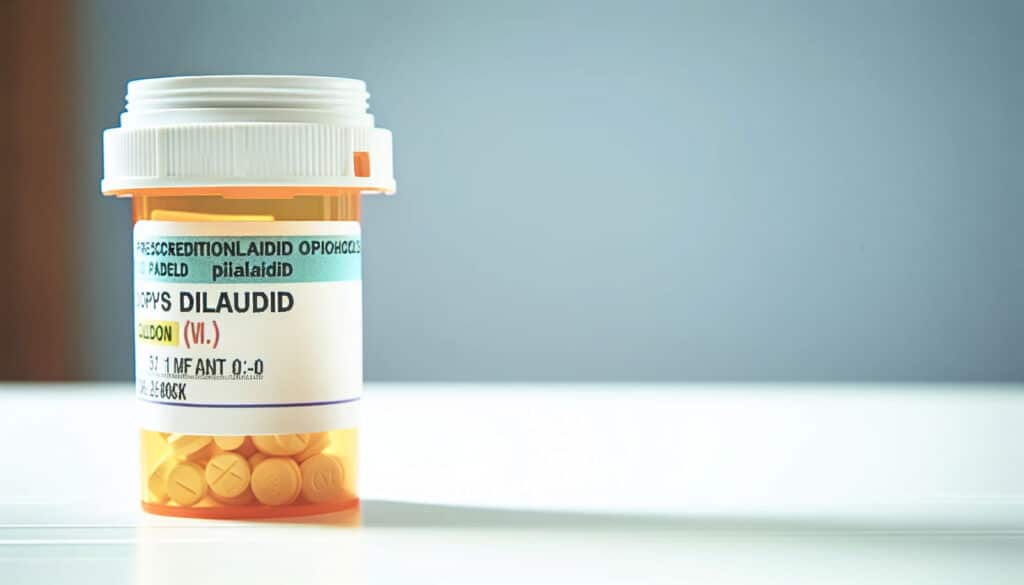The battle against Dilaudid (hydromorphone) addiction is one that many individuals face, often with the risk of significant consequences. Fortunately, recovery is possible with the right information and tools at hand. This comprehensive guide aims to provide a better understanding of Dilaudid addiction treatment, detoxification, managing withdrawal symptoms, and long-term recovery strategies.
By learning about the usage and risks of Dilaudid, recognizing withdrawal symptoms, understanding the withdrawal timeline, and exploring medical detox options, individuals facing addiction can become better equipped to take the necessary steps toward recovery. With proper guidance and support, overcoming Dilaudid addiction can be achieved.
Table of Contents
- 1 Key Takeaways
- 2 Understanding Dilaudid: Usage and Risks
- 3 Recognizing Dilaudid Withdrawal Symptoms
- 4 The Dilaudid Withdrawal Timeline
- 5 Medical Detox for Dilaudid Withdrawal
- 6 Coping Strategies for Dilaudid Withdrawal
- 7 Long-Term Recovery from Dilaudid Addiction
- 8 Preventing Dilaudid Relapse
- 9 Summary
- 10 Frequently Asked Questions
Key Takeaways
- Understand Dilaudid usage and risks to avoid addiction.
- Recognize physical and psychological withdrawal symptoms for professional assistance.
- Seek medical detox, MAT, and inpatient/outpatient care for safe management of the withdrawal timeline. Commit to ongoing treatment & lifestyle modifications for long-term recovery from addiction.
Understanding Dilaudid: Usage and Risks

Dilaudid, a potent prescription opioid drug, is typically prescribed to treat moderate to severe pain by acting on opioid receptors. However, its potency and potential for Dilaudid abuse have led to its classification as a Schedule II controlled substance, highlighting the need for caution and proper medical supervision when using opioid drugs. When misused, Dilaudid can result in addiction and severe withdrawal symptoms. Moreover, combining Dilaudid with substances such as alcohol can lead to dangerous health complications, including lowered blood pressure, breathing difficulties, fainting, and even coma.
Assessing the risks of Dilaudid use is key to avoiding addiction and securing proper treatment if opioid dependence ever arises. Some potential dangers of Dilaudid use include:
- Addiction and dependence
- Respiratory depression
- Overdose
- Withdrawal symptoms
- Interactions with other medications
Awareness of these risks allows individuals to make wise health-related choices and take necessary precautions when using this powerful prescription drug.
Recognizing Dilaudid Withdrawal Symptoms
An important step toward addressing Dilaudid addiction, a form of drug abuse, is identifying possible withdrawal symptoms. These symptoms can range from physical discomforts, such as nausea and muscle aches, to psychological symptoms, like anxiety and agitation.
Recognizing these symptoms can alert individuals and their support systems to the need for professional help.
Physical Symptoms
Physical symptoms associated with Dilaudid withdrawal can vary in severity and may include nausea, muscle aches, sleep disturbances, stomach cramps, diarrhea, and vomiting. The intensity of these symptoms can be overwhelming, and in some cases, individuals may experience acute withdrawal symptoms such as anxiety, fever, sweating, cravings for the drug, vomiting, diarrhea, chills, muscle spasms, aches, pains, depression, confusion, and suicidal thoughts. It’s essential to recognize the symptoms of withdrawal to ensure proper care and support during this challenging process.
Due to the potential severity of physical symptoms and the risk of developing physical dependence on other opioids, professional help during the withdrawal process is recommended. Medical supervision can aid in symptom management, offering a safer and more comfortable detox process.
Psychological Symptoms
Psychological symptoms of Dilaudid withdrawal can be challenging to navigate as they may persist even after physical pain symptoms subside. These symptoms can include:
- Anxiety
- Depression
- Confusion
- Suicidal thoughts
The lingering psychological symptoms, often associated with chronic pain, can impact daily life and activities, such as concentration, mood, motivation, and the ability to handle normal routines and responsibilities.
Professional assistance and medical and psychological care support are recommended during the withdrawal process to manage these psychological symptoms effectively. Mental health services administration, therapy, and counseling can help individuals develop coping strategies and provide a support system to aid in recovery.
The Dilaudid Withdrawal Timeline
The timeline for Dilaudid withdrawal can vary, typically commencing within 4-8 hours after the last dose and persisting for up to two weeks or longer. Factors that can influence the withdrawal process include:
- Dosage
- Duration of use
- Method of intake
- Individual differences in metabolism
Comprehending the withdrawal timeline is key to anticipating and managing withdrawal symptoms effectively. As symptoms generally peak within the first few days and subside within 10-14 days, individuals can better prepare for the challenges they may face during this withdrawal period and seek the appropriate support and treatment as needed.
Medical Detox for Dilaudid Withdrawal
Medical detox provides a safe and effective method for managing Dilaudid withdrawal, offering options such as medication-assisted treatment (MAT) and inpatient or outpatient care. Undergoing medical detox allows individuals to receive professional support and treatment to alleviate withdrawal symptoms and assist recovery.
Medication-Assisted Treatment (MAT)
Medication-Assisted Treatment (MAT) involves the use of FDA-approved medications, such as buprenorphine, methadone, and naltrexone, to help alleviate withdrawal symptoms and reduce cravings. MAT has been proven to be effective in managing Dilaudid withdrawal, increasing the likelihood of successful recovery, and preventing relapse.
However, it is important to note that there are potential risks and side effects associated with MAT and opioid medications, such as the possibility of individuals attempting to treat their symptoms with illicit opioids or experiencing opiate withdrawal syndrome. Using MAT for Dilaudid withdrawal requires careful monitoring and proper dosage under medical supervision.
Inpatient vs. Outpatient Detox
Inpatient detox provides a structured environment with 24/7 medical supervision, offering advantages such as constant monitoring, medication administration, and a seamless transition to subsequent outpatient treatment programs. On the other hand, outpatient detox allows for more flexibility and independence, enabling individuals to continue with daily responsibilities and receive support from family and friends during the detox process.
Both inpatient and outpatient detox options have advantages and challenges; the choice between them depends on the individual’s needs, circumstances, and preferences. Regardless of the method chosen, professional support and treatment are recommended to ensure a safe and effective full withdrawal management process.
Coping Strategies for Dilaudid Withdrawal

Developing coping strategies can greatly aid individuals in managing Dilaudid withdrawal symptoms. Staying hydrated can help manage symptoms such as sweating, diarrhea, and muscle aches. Engaging in physical activities like exercise, yoga, and walking can also provide a positive and healthy outlet for stress and discomfort during uncomfortable withdrawal symptoms.
In addition to these self-care strategies, seeking support from friends, family, or support groups can be invaluable in navigating the challenges of withdrawal. Receiving emotional support, encouragement, and understanding from loved ones can significantly impact recovery.
Long-Term Recovery from Dilaudid Addiction
Long-term recovery from Dilaudid addiction involves:
- Ongoing therapy
- Support
- Lifestyle changes to maintain sobriety and prevent relapse
- Mental health counseling
- Medication-assisted withdrawal treatment
- Support groups for continuous support and relapse prevention
These components are integral to a successful long-term recovery plan.
Lifestyle modifications that can further bolster long-term recovery include:
- Avoiding triggers
- Establishing a strong support system
- Participating in regular physical exercise
- Implementing stress management techniques
- Cultivating new hobbies and interests
By embracing these changes and committing to ongoing treatment and support, individuals can achieve lasting sobriety and a life free from Dilaudid addiction, a form of opioid addiction.
Preventing Dilaudid Relapse
Preventing Dilaudid relapse is a critical aspect of long-term recovery from substance abuse (substance use disorders). A strong support system, ongoing therapy, and healthy coping mechanisms can help individuals manage stress and triggers that may lead to relapse. Recognizing and addressing common catalysts for relapse, such as stressors, peer influence, and cravings, is essential in maintaining sobriety.
Seeking help from friends, family, and support groups can also provide encouragement and accountability during recovery. Maintaining vigilance and commitment to sobriety can aid individuals in preventing Dilaudid relapse and achieving a healthier, addiction-free life.
Summary
In conclusion, overcoming Dilaudid addiction requires understanding the risks, recognizing withdrawal symptoms, navigating the withdrawal timeline, and exploring medical detox and long-term recovery options. By seeking professional help and support, individuals can manage withdrawal symptoms, prevent relapse, and achieve lasting sobriety.
The road to recovery may not be easy, but with determination, persistence, and the right resources, individuals can reclaim their lives from Dilaudid addiction and enjoy a brighter, healthier future.
Please call Allure Detox today to learn more!
Frequently Asked Questions
What is one of the first signs of withdrawal?
What happens when you stop taking medication?
What are the most common physical and psychological symptoms of Dilaudid withdrawal?
How long does Dilaudid withdrawal typically last?
What are the advantages of Medication-Assisted Treatment (MAT) for Dilaudid withdrawal?
Published on: 2019-06-19
Updated on: 2024-04-23


